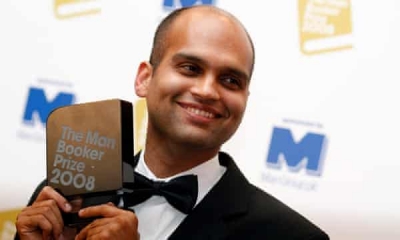What is the story of author Aravind Adiga?

Aravind Adiga made headlines more than 12 years ago when he won the Man Booker Prize in 2008. Aged 33 at the time, he became the second-youngest author to win the coveted literary prize. Before him, Ben Okri won it at the age of 32 in 1994. Eleanor Catton (25) is the youngest-ever, having won the prize in 2013.
And the fact that Adiga was a first-time author cemented his place among the literary greats. Today, there is hardly a reader in India who has not heard about Adiga and the White Tiger (even if they have not read it.)
Early life
Adiga was born in Chennai on October 23, 1974. Later, he moved to Mangalore (Mangaluru) with his family. Growing up in the provincial town, Adiga’s mother, Usha helped him cultivate a healthy reading habit. Since it was expensive to buy books, he joined a circulating library that would lend books at a nominal rate. Like other children his age, Adiga devoured comics and Hardy Boys. But he was getting bored with the typical fare for young adult readers. On the recommendation of a librarian, Adiga read Oscar Wilde and Agatha Christie. Christie’s unique narrative technique – using the murderer as a narrator in the Murder of a Roger Ackroyd – fascinated him. It inspired his Booker winning debut novel The White Riger.
Soon even the library had nothing more to offer the avid reader and so, Adiga started combing through his grandfather’s cupboards to find new titles to read. He was not disappointed. His grandfather, a local lawyer, kept his cupboards well-stocked with the works of prominent British writers Somerset Maugham, G.K. Chesterton, G.B. Shaw, and J.B. Priestley.
Tragedy strikes
At 16, Adiga lost his mother and suddenly his world turned upside down. Leaving behind his beloved town, Adiga moved to Australia along with his father. Holding a dual citizenship of India and Australia, Adiga spent some of his teenage years in Parramatta in Sydney, where he attended The James Ruse Agricultural High School.
Mangaluru and Sydney were worlds apart, but writing helped Adiga cope with his new environment. He devoted himself to writing and often spent whole nights typing away on his computer.
Journalism years
Adiga’s clarity of ideas, freshness of approach and exceptional grasp of topics earned him praise from his teachers. He went onto study English Literature at Columbia University in New York and then at Magdalen College, Oxford. Despite spending years abroad, he felt the pull to return to India. And so after graduation, he started working as a financial journalist in the capital. Working with Financial Times, he covered the dynamic world of stock markets and investments and later contributed to Time magazine in Delhi. But the desire to become a writer was so strong that he quit his job and moved to Mumbai to focus on writing.
Maximum city
Living in a dingy one bedroom apartment in the crowded suburb of Santacruz, Adiga hoped that the Maximum city would be his muse. The British Council library in Nariman Point, Prithvi Café in Juhu and small Udupi restaurants became his daily haunts. The city helped him discover his voice as a writer and soon, he gained international recognition for his first book, The White Tiger about a rickshaw puller’s son rising from the depths of poverty in rural India to becoming an entrepreneur in Bengaluru. It paints a scathing picture of the corruption and greed rampant in the country.
His subsequent works Last Man in Tower and Selection Day paid ode to the City of Dreams, Mumbai. In Last Man in Tower, Adiga captures the harsh realities of Mumbai’s real-estate market, while he focusses on the aspirations of its young in Selection Day.
His latest book, Amnesty, is a tale about an ‘illegal’ migrant from Sri Lanka who is caught in a moral dilemma in Australia.
Oh Really?
- Adiga was a state topper in his Class X board examinations.
- His mother, Usha, inculcated a love of reading in the young Adiga.
- As a financial journalist, Adiga once interviewed the current U.S. President Donald Trump.
- In 2008, Adiga became the second-youngest writer to win the £50,000 Man Booker award.
- In 2017, his novel Selection Day was shortlisted for the DSC Prize for South Asian Literature. The book has been adapted into a Netflix series starring Mahesh Manjrekar and Ratna Pathak.
Picture Credit : Google
